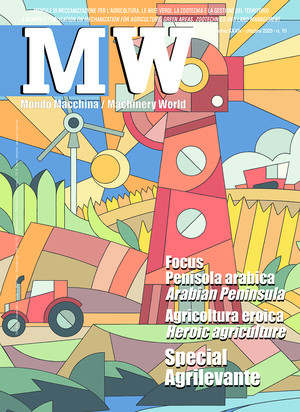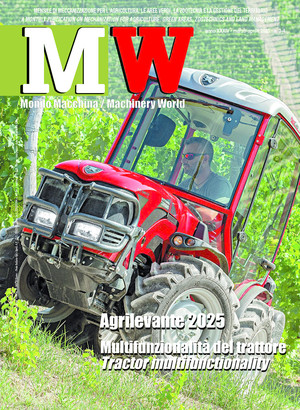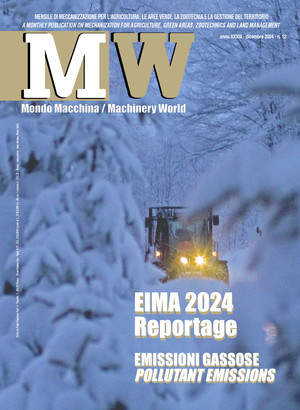
Systems for reducing tractor gas emissions
Knowing the actual power requirements of agricultural machinery prevents tractor oversizing. In addition to significant economic savings, this translates into improved engine efficiency, which also leads to a tangible reduction in pollutant emissions
The use of internal combustion engines, especially those powered by fossil fuels, is now recognized as a leading source of air pollution and a major threat to human health. The combustion of diesel fuel, still the preferred fuel for work vehicles, generates various pollutants, including particulate matter (PM), nitrogen oxides (NOx), carbon monoxide (CO), and unburned hydrocarbons (HC). To address this issue, Europe and the United States introduced specific environmental regulations in 1996 to limit emissions from engines installed in "non-road" vehicles, i.e., vehicles intended for off-road use. Similar to the "Euro" regulations applied to the automotive sector, the non-road industry has been subject to specific standards: "Stage" classification in Europe (from Stage I to Stage V) and "Tier" regulations in the United States (from Tier 1 to Tier 4 Final). These regulations introduced progressively stricter limits on permissible emissions to encourage technological innovation and promote environmental sustainability.
Compliance with these limits requires a complex technical approach. Work has been carried out to optimize engine combustion efficiency through supercharging, electronic management, and ultra-high-pressure injection. Additionally, one or more complementary systems or devices have been applied, such as exhaust gas recirculation (EGR), particulate filters (DPF), selective catalytic reduction (SCR), and oxidizing catalysts (DOC) (see box).
Improving engine performance. Several decades ago, the application of turbochargers (even better with variable geometry) improved combustion in internal combustion engines by allowing diesel fuel to be burned in "excess air," ensuring the most efficient fuel-air ratio under all operating conditions. Another relatively recent innovation that has greatly improved performance is common rail technology, which allows fuel to be injected at very high pressure (over 2000 bar) in a precise and controlled manner. This results in finer diesel atomization, enabling it to mix more effectively with the oxidizer (i.e., the oxygen in the air), leading to more complete combustion and, consequently, a lower environmental impact.
For some time now, specific electronic control units (ECUs) have ensured the increasingly complex and sophisticated management of modern engines. These highly advanced systems adapt the engine's operating conditions in real-time using sensors that detect pressure, temperature, airflow, and oxygen content. These sensors allow the control units to dynamically adjust the injection timing, EGR valve activity, and supercharging parameters, contributing to precise combustion control. The shape of the combustion chamber also plays a crucial role in the efficiency of fuel and oxidizer mixing. The use of alternative fuels, such as biodiesel and HVO, can further reduce pollution.
Maximum and partial power engine curves. To maximize efficiency and reduce power waste and excessive consumption, it is essential to carefully analyze the performance of different engines and obtain performance curves in terms of torque, power, and specific consumption. This data is usually obtained through experimental bench tests and provides useful information for managing the engine correctly in relation to the transmission and load requirements. Under full-load conditions (i.e., when the accelerator is fully pressed), as resistance torque increases, the engine responds with an equivalent increase in driving torque and a simultaneous reduction in speed. Increasing the resistance torque further reveals a maximum torque speed beyond which the torque decreases. Maximum power usually occurs at a speed close to the maximum, while minimum specific consumption (i.e., maximum engine efficiency) occurs at an intermediate value.
However, constant operation at full load is rare in actual engine use, especially in agriculture, transportation, and industrial applications, where engines operate at less than maximum power for long periods. It is precisely in these areas that the so-called "partial load" engine curves occur. These curves describe how torque, power, and specific consumption vary as speed changes but always at load levels below 100%. For example, the curves might show values at 25%, 50%, or 75%. These curves more realistically represent the actual use of the vehicle, thus allowing for a more accurate analysis of the engine's overall efficiency.
As a matter of fact, these curves make it possible to identify certain "operating points," or the best operating conditions where the engine shows the lowest possible specific consumption. This information is key for optimizing performance in real situations and reducing fuel consumption, pollutant emissions, and wear and tear on mechanical components. Partial load analysis plays an even more strategic role in developing electronic control logic because it allows for precise calibration of injection, supercharging, and exhaust gas recirculation management. This adaptation of engine operation to operational requirements does not compromise efficiency.
The agricultural sector. In agricultural applications, correctly assessing tractor engine performance relative to the operating machines' actual power requirements is essential for evaluating the activity's energy efficiency and economic sustainability. Although tractor technical specifications offer a wide range of nominal and maximum power ratings, the actual energy requirement during fieldwork is often well below the available maximum power. This discrepancy is particularly clear in light work such as road transport and operations involving low-power-consumption equipment such as universal seeders, weeders, rakes, and fertilizer spreaders.
A detailed analysis of equipment usage profiles allows one to identify the ideal engine speed and the actual (partial) load conditions under which the power train operates most of the time. In many cases, the actual power demand is between 30% and 60% of the maximum. Therefore, an engine designed to deliver high performance at full load may be less efficient when operating at reduced loads and intermediate speeds. If the tractor is oversized for its operating requirements, power waste is generated. This results in unnecessary and systematic energy dissipation with multiple negative consequences. First, fuel consumption increases because the engine operates far from its maximum efficiency point. The surplus power can also lead to increased pollutant emissions and greater wear and tear on after-treatment devices and, more in general terms, all moving parts. Economically speaking, oversizing results in higher purchase and operating costs and less rational management of the company fleet. For these reasons, it is important to take a sensible technical approach to selecting tractor power based on an analysis of the equipment's energy requirements and operating conditions. Selecting an engine calibrated to the torque, power, and specific consumption curves at partial loads allows to achieve an ideal compromise between performance, fuel consumption, and environmental sustainability.
Anti-pollution devices
To comply with the strict limits imposed by the latest versions of the relevant regulations, optimizing combustion is no longer enough; various specific anti-pollution solutions are essential. The most commonly used on engines for vehicles intended for use in the non-road sector are EGR, DPF, SCR, and DOC.
EGR (exhaust gas recirculation) involves reintroducing a portion of exhaust gases into the combustion chamber to reduce the temperature at which diesel fuel burns. This reduces the formation of nitrogen oxides (NOx).
The DPF (diesel particulate filter) is a physical filter with a honeycomb structure that traps solid particulate matter (PM) generated by the combustion of diesel fuel.
The SCR (selective catalytic reduction) system works by spraying a urea solution (AdBlue) onto the exhaust gases. In the presence of a catalyst, this solution converts NOx into nitrogen (N₂) and water vapor (H₂O).
DOC (diesel oxidation catalyst) promotes the oxidation of carbon monoxide (CO) and unburned hydrocarbons (HC). This improves the quality of the gases entering the DPF, helping to maintain its original operating characteristics.
To meet increasingly strict regulatory limits, these systems must be applied more often and in a coordinated, synergistic manner to ensure combined action on all main pollutants.








